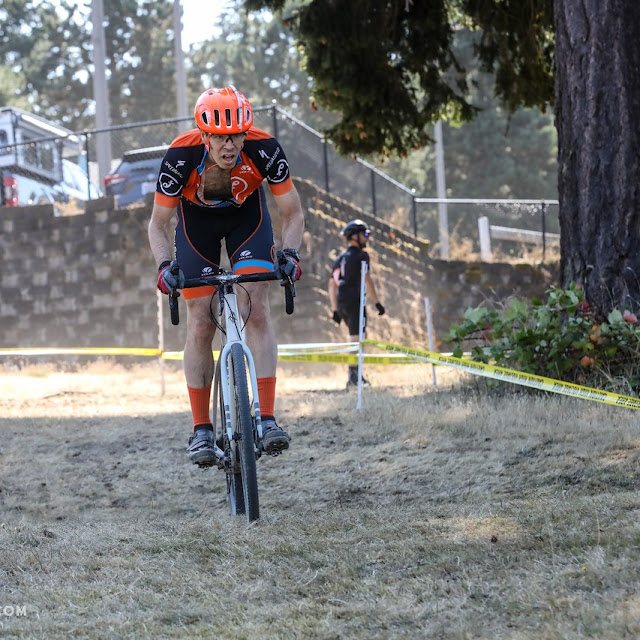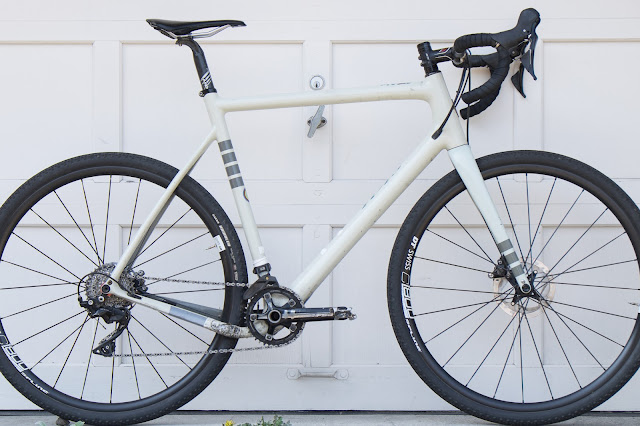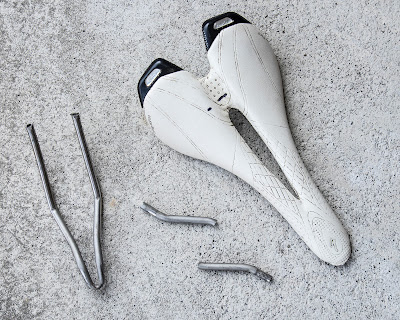A single corner at my last cyclocross event unwound my entire race. The corner in question featured a slight decline and quite dry sand. Lap after lap I failed to navigate the sand. At the end of the day I guessed that my poor execution in this one corner cost me about 90 seconds over my hour of racing. Those lost seconds have motivated this blog post and hopefully a chance to avoid a similarly large error in the future.
The corner in question required bike handling skills and a real time tactical choice to ride or run. Riding was fastest. Running was slower. Attempting to ride, failing, and resuming on foot was slowest. No measurements were available so I'll share my best estimates of ten seconds to ride, fifteen to run, and thirty if a ride attempt failed. Running affects my heart rate negatively and those downstream affects are included in my time estimates.
There was a large risk and small reward for attempting to ride the sand section. And therefore the question is why, in the moment, I made the risky choice to ride the sand corner seven of seven laps despite my string of failed attempts.
The answer is poor assumptions. First, however, some background information that informed my assumptions.
1. Riding was faster than running.
2. On my first sighting lap I realized the challenge of the sand corner and rode it repeatedly to verify riding was a choice with a high percentage of success.
3. During the race I was watching for evidence that other riders were resorting to running the sand and found none.
4. My bike handling is solid (usually). If my competitors can ride an obstacle likely I can as well.
5. During the race I was tracking the changes in the sand section.
If I look at all these points of information statically it appears running is the better tactical choice. Adding in the dynamic points of changing sand conditions and lack of other runners still pointed to riding the sand. On race day this was the end of my analysis and it cost me dearly.
After stewing on my failure for a week my false assumptions became more clear.
The changing sand conditions were eroding two of my data points. The number of seconds to ride the sand was inching up and the ride success percentage was inching down. I wasn't taking this into account in real time.
My second poor assumption regards the absence of other runners. My failure to see runners does not disprove their existence. I suspect plenty of my competitors were choosing to run. I failed to consider this possibility and subsequently failed to reconsider my ride vs run choice.
My general assumption that good bike handling applies to every patch of sand was too optimistic. This short stretch was not in my wheelhouse.
Bringing it all together I believe I was operating with generally good information and thought processes. These general principles were in play for every challenging section of the course and bringing good results everywhere save the sand section. A few poor assumptions, however, conspired to undermine my real time thinking process.
Going forward I want to close the door on this type of failure. Which is a tough nut to crack. Reasoning through my race day assumptions while executing 400 watt intervals on the bike is not feasible.
I do possess another feedback system. It runs the software in my head that is informed by my race experience. This system is subjectivity. I needed no stopwatch to know after my first failed attempt at riding the sand that my execution was 'bad'. After my second or third failure the switchboard for this system was aglow with red blinking lights.
As I continue to contemplate the sand section failure I hope to update my decision system by adding subjectivity as a reality check. When I am riding well I plan to allow data and assumptions to run the tactical decision show. When the primary system leads to a subjectively 'bad' decision I need to be more open to quickly hitting the reset button.
The Cross Revolution series takes us next to Arlington where I'll try to update my real time decision making. Expect me to write about it soon.
A competitive cyclist shares his passion for gravel racing and the philosophical thoughts that fill his head during the hours of pedaling.
Sand Section Lesson
Cross Revolution at Evergreen HS
Cross Revolution took us to the Evergreen High School venue and race day found us under sunny skies and 70 degree warmth. The course was, of course, dry. It seemed pretty fast and contained quite a few short, steep ascents. In general it was similar to last year's event at this venue.
As the first race on my calendar I was using this race to evaluate this year's equipment and fitness.
The Bike
I was not alone in choosing to race a Ibis Hakka MX. During warm up I noticed there were at least five Hakkas in the same color as mine. While waiting on the start line I noticed a few more. This boosted my confidence in my equipment. But the real test happened on the course and the Hakka shined. I'm adapting well to the less precise steering at low speeds. At speed the handling was rock solid stable. And it railed the fast corners.
The Tires
Cornering speed is dependent on tires and my choice of tubeless Maxxis Ramblers in 40mm was an outlier. A quick survey indicated most racers were sticking with 33mm wide tires. Luckily a racer I know was also testing a set of Ramblers. And this racer knows his way around a cross course. When I asked Craig Undem about his experiences so far he admitted this was his first race on the Ramblers. We agreed to share notes after the race.
My Fitness
Racing cyclocross requires short bursts of power. I can match the fast guys' accelerations once or twice or even twenty times. Cyclocross racing requires hundreds of these short efforts. The power numbers from my power meter don't tell the whole story. An hour of racing did.
Cat 1/2 Master Men 45+
I lined up in the second row behind Craig. He knew that when 25 racers funneled into the first few turns there would be mayhem. When he powered off the line I dug deep to stay on his wheel. After a handful of quick turns the course straightened and I found myself in fourth and well ahead of the traffic jams. After letting one rider come by on the next straight I clamped on to the tail end of the lead group for as long as I was able.
 |
| Cat 1/2 Master Men 45+ start. Photo courtesy Woodinville Bicycle. |
The run up exposed a crack in my fitness. The other members of the lead group didn't show as much hurt when we remounted at the top.
The sand section exposed another weakness. I bobbled, had to put a foot down, and watched the leaders ride away.
Lap two played out a lot like the first lap except I raced with the chase group. This group was also about five. This group also rode away when I, again, botched the sand section.
In the moment I realized I was matching the power and corning speed of the riders in these two groups. But my frustration was growing with my bike handling in the sand section.
For the remainder of my race I rode mostly alone. The patterns established on laps one and two were repeated. Get crushed by the run up. Recover well enough a few turns later. Then botch the sand section where I would both lose time and put out extra effort to run the bike out of the sand. Had I been racing against the sand section it would have been judged the winner. In seven laps I rode it clean just once. On four of the laps I bobbled, lost momentum, and then dismounted to finish the section on foot. Twice I hit the deck.
 |
| Dwaine concentrates during one of the many short grassy descents at Evergreen HS. Photo courtesy Woodinville Bicycle. |
On my second to last lap the leaders of the Cat 1/2 men race were closing in and threatening to put me a lap down. I focused myself, barely stayed away, and earned myself the privilege of one more lap. I finished 14th of 22 finishers in my class.
Findings
Sand Sucked. Most days I can find the bike handle. But the short sand section had my number. There is, however, more to this story. My poor performance led me to do some serious thinking on why the wheels fell off and how I will get them back on. Expect a blog post about this topic next week.
Fitness OK. On the sections of the course that did not require running I was pretty pleased with my fitness. More often than not I could push watts into the accelerations and find enough recovery to repeat.
Run up not OK. My legs felt weak. My heart rate hit the ceiling. The run up became my Kryptonite.
Tires. I was staring at the ground with drool escaping when Craig approached me after the race. Despite identical tires we experienced different race outcomes. Craig took his Ramblers to 3rd place. Chapeau.
We shared our thoughts on the Maxxis Ramblers and found consensus. They sucked up the bumps well. We both ran pressure in the low 20's and appreciated the lack of sharp jolts coming through the saddle. Cornering was predictable and on par with a typical 33mm file tread. The Ramblers also gave great feedback. There was a slight sense of tire rollover when a tire was overloaded. When the limit of traction was reached they let go predictably.
Evergreen High School was not my break out race. But the news was not all bad. My equipment choices were solid. Despite a single race in the books this boosted my confidence about this year's equipment and I'm looking forward to spending more energy on race craft and training. I'm also encouraged by some aspects of my fitness and feel like there is still a little more to be found.
Finally, the difficulties in the sand section have forced me to challenge some of my assumptions. I've heard you either win or learn. This week the sand chose for me and I'll be back next time a little wiser.
Pre Season Cross Topics
Cyclocross season 2022 is getting underway. My first event is a few days out. That event will be the initial test for my revised training plan and revolutionized equipment.
Training
Training in 2022 has been my most deliberate. Training workloads were chosen with purpose. Early year training for gravel racing, late year training for cyclocross. This was also the year where planned rest weeks were formally incorporated.
January to March was dominated by endurance paced base miles. A few high intensity Zwift events were sprinkled in to keep it zesty. Those Zwift events were later replaced with more structured intervals for a traditional 'build' phase.
Summer was a mixture of racing at Pacific Raceways and the mental reset of a few extra rest weeks.
July brought another transition. Volume was trimmed to accommodate two structured workouts per week. The intensity notched up with the dreaded 30/30's in late August to more closely match the demands of cyclocross.
Unlike previous years the transition from Summer season to cyclocross season was well scripted. Having invested the time to create a concrete pre season training plan motivated me to execute every one of those interval sessions. Only time will tell if the story line concludes with an improvement in my fitness compared to previous years.
Equipment
Back in 2019 I purchased an Ibis Hakka MX frameset and built it into a gravel racing rig. In 2022 The Hakka will supplant my twelve year old Blue Norcross cyclocross race bike. After swapping a few parts and stripping off the gravel gear I spent a few hours riding my neighborhood cyclocross training grounds. The first ride was to verify mechanical fitness. Subsequent rides were spent evaluating the handling. While designed as a cyclocross race bike it feels substantially different from my familiar Norcross.
 |
| Ibis Hakka MX ungraveled and ready to race CX |
I've raced just two cross bikes in the last ten years. Both were built by Blue and shared identical geometry. I would describe them as quick steering and having high bottom bracket heights. Initially I was intimidated but eventually learned to appreciate those handling characteristics.
The geometry numbers for the front end of the Hakka MX are pretty close to the Blue. Yet the steering feels less precise. Where I do see a difference in geometry is in the wheelbase and bottom bracket height. The Hakka is longer and lower. Those properties are appreciated when gravel racing. Those properties might also provide me a new learning opportunity this cyclocross season.
 | |||||
| This is why we test. Last cross season this saddle probably saw over twenty hours of use. It came home in pieces less than twenty minutes into this year's first test ride. |
Complicating the switch from old to new is tire selection. The Blue was shod with 33mm tubulars. They worked in the mud and I hated them everywhere else. It was time to move up to a larger volume tubeless tire. While not the perfect choice a large volume tire was already mounted. The Hakka will start the season with 40mm Rambler gravel tires. I know what to expect from these tires in the context of gravel racing. At low pressures and deep lean angles they might show a different face. It is my intention to swap them out for a more cross specific tire sooner than later.
Each September I want to believe it will be 'my year'. Each December I hang up a thrashed bike with grand plans to make next Fall even better. This year I intend to write some pages to tell the story between those bookends.